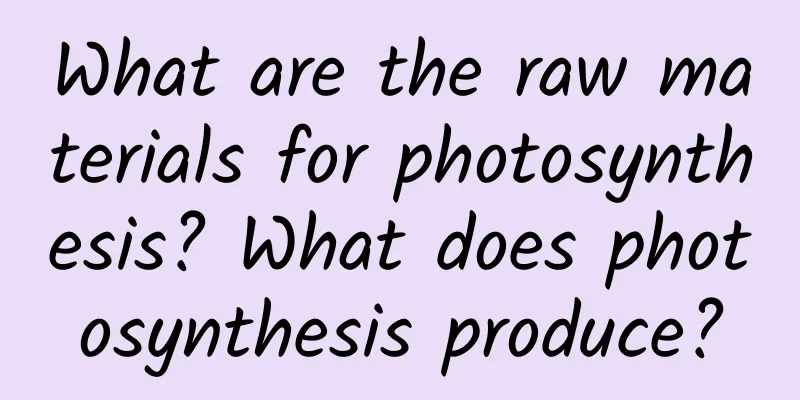What are the raw materials for photosynthesis? What does photosynthesis produce?

|
Photosynthesis usually refers to the process by which green plants absorb light energy, synthesize carbon dioxide (CO2) and water (H2O) into energy-rich organic matter, and release oxygen at the same time. I believe everyone knows this because we have come into contact with it in textbooks and in life, but what are the raw materials of photosynthesis? What does photosynthesis produce? What is the whole process of photosynthesis like? If you want to know more in-depth knowledge, please open the article below to have a look! Contents of this article 1. What are the raw materials for photosynthesis? 2. What does photosynthesis produce? 3. The whole process of photosynthesis 1What are the raw materials for photosynthesis?The raw materials for photosynthesis are water and carbon dioxide. Photosynthesis usually refers to the process by which green plants absorb light energy, synthesize carbon dioxide and water into energy-rich organic matter, and release oxygen at the same time. Photosynthesis is divided into two stages: light reaction and dark reaction. During the light reaction stage, chlorophyll converts light energy into electrical energy and then into active chemical energy and stores it in ATP. During the dark reaction phase, the active chemical energy in ATP is converted into stable chemical energy in organic substances such as sugars. 2What does photosynthesis produce?Photosynthesis produces water and organic matter. The process of photosynthesis is as follows: Photosynthesis is a biochemical process in which green plants use photosynthetic pigments such as chlorophyll and certain bacteria, such as halophilic archaea with purple membranes, use their cells themselves to convert carbon dioxide and water, or hydrogen sulfide and water for bacteria, into organic matter under the irradiation of visible light, and release oxygen, or hydrogen released by bacteria. 3The whole process of photosynthesisPhotosynthesis usually refers to the process in which green plants (including algae) absorb light energy, synthesize energy-rich organic matter from carbon dioxide (CO2) and water (H2O), and release oxygen at the same time. Light reaction stage: The characteristic of the light reaction stage is that the electrons released by the oxidation of water molecules driven by light are transferred to the thylakoid cavity through an electron transfer system similar to the electron transfer chain of mitochondrial respiration, so that it is reduced to. Another result of electron transfer is that protons in the matrix are pumped into the thylakoid cavity, and the transmembrane proton gradient formed drives phosphorylation. Dark reaction stage: The dark reaction stage uses the NADPH and ATP generated by the light reaction to assimilate carbon, so that the gaseous carbon dioxide is reduced to sugar. Since this stage is basically not directly dependent on light, but only on the supply of NADPH and ATP, it is called the dark reaction stage. The place of dark reaction is the chloroplast matrix. |
<<: What are the conditions for photosynthesis? Can all living things perform photosynthesis?
Recommend
Side effects of taking Wangbuliuxing tablets
If you want to know the side effects of Echinops ...
What causes pain on the left side of the lower abdomen during pregnancy?
For a pregnant woman, there are many things that ...
What are the symptoms of low back pain when you are pregnant?
Any mother who has ever been a mother can underst...
Breast hyperplasia lumps
In the case of breast hyperplasia lumps, we can u...
What should I pay attention to when my uterus recovers after a normal birth?
Giving birth is a relatively natural thing, but n...
What does hemolysis mean for pregnant women with type O blood?
Pregnant women may experience hemolysis due to bl...
Can Jiayin treat pelvic effusion?
Pelvic effusion is a disease that many women suff...
How many milligrams of iron should pregnant women take every day
Iron is very important for both normal women and ...
How big is the belly in 22 weeks of normal pregnancy
When a woman reaches the middle stage of pregnanc...
What meat is used to make fish-flavored pork shreds? Which part of the pig is used to make fish-flavored pork shreds?
We all know that fish-flavored shredded pork is a...
Causes of lower abdominal pain in girls
In today's daily life, many women have to fac...
I take a walk after three meals a day, but my heart vessels are still blocked. What's going on?
I take a walk after three meals a day, but my hea...
What are the obvious symptoms of vulvar itching?
Vulvar itching is a symptom of various gynecologi...
Is it normal for vaginal discharge to be like yogurt?
Leucorrhea is a metric for judging whether women ...
How to choose fresh grass carp? Which parts of grass carp cannot be eaten?
Grass carp is popular among consumers for its ten...









